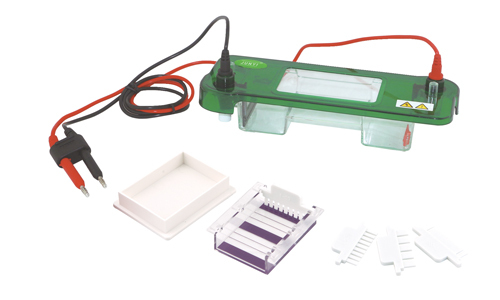A power source for electrophoresis is the source that manages constant and direct current to the electrophoresis system, as well as indicates and allows us to control both the supply voltage and the current consumption. In other words, this device provides the necessary energy for this system to function properly; and this important laboratory technique can be carried out.
The power of the Electrophoresis Power Source is designed for use in separating DNA, RNA, and proteins. Therefore, failures in the power supply of the electrophoresis system, can in turn cause failures in the execution of the technique, which is why we must ensure that said source works in the correct way and that its capacity is sufficient to cover the power requirements of all internal components of the system.
A power source for electrophoresis systems works by converting the alternating current that comes from the electrical supply, into direct current, and distributes it to the devices that request it. That is why it acts as a transformer, rectifier and as a regulator at its output, to avoid voltage peaks that damage the system.
The power source for electrophoresis systems converts the alternating current that comes from the electrical supply, into direct current, and distributes it to the devices that request it. That is why it acts as a transformer, rectifier and as a regulator at its output, to avoid voltage peaks that damage the system.
Characteristics of a power source
The main characteristics of a power source refer to its capacity. Among them we can mention:
- Voltage: Refers to the voltage range that a source is capable of providing, it is important to ensure that our source complies with the voltage ranges for all our applications, because this range cannot be exceeded.
- Current: Specifies the current range that the power source can provide. Like the voltage characteristic, this range cannot be exceeded.
- Power: This parameter indicates the maximum combination of voltage and current that the source can give us. It is very important to verify this characteristic since there are dual-range or multi-range sources that are limited by their power but allow different ranges of voltage and current.
What is the principle of electrophoresis?
Electrophoresis is a laboratory technique that is based on the migration of molecules through a gel or matrix of a porous nature, where by the application of an electric field, they will be separated according to their size or molecular weight, this thanks to the action of a power source for electrophoresis chambers.
Electrophoresis chambers can be classified according to the way the support is arranged, horizontally or vertically. The horizontal ones are characterized because the buffer completely covers the gel, it has some wells in which the sample is deposited; those of the vertical type are used exclusively with polyacrylamide gel.
One of the key aspects in performing electrophoresis is the electrical part related to the supply of current and voltage necessary for the separation of the components to be studied, since without an adequate power source for the electrophoresis system it is impossible to obtain optimal results in the execution of electrophoresis.
At Kalstein we are MANUFACTURERS and we offer you an innovative electrophoresis system with an excellent power source, at the best PRICES on the market since we are MANUFACTURERS. That is why we invite you to take a look HERE

